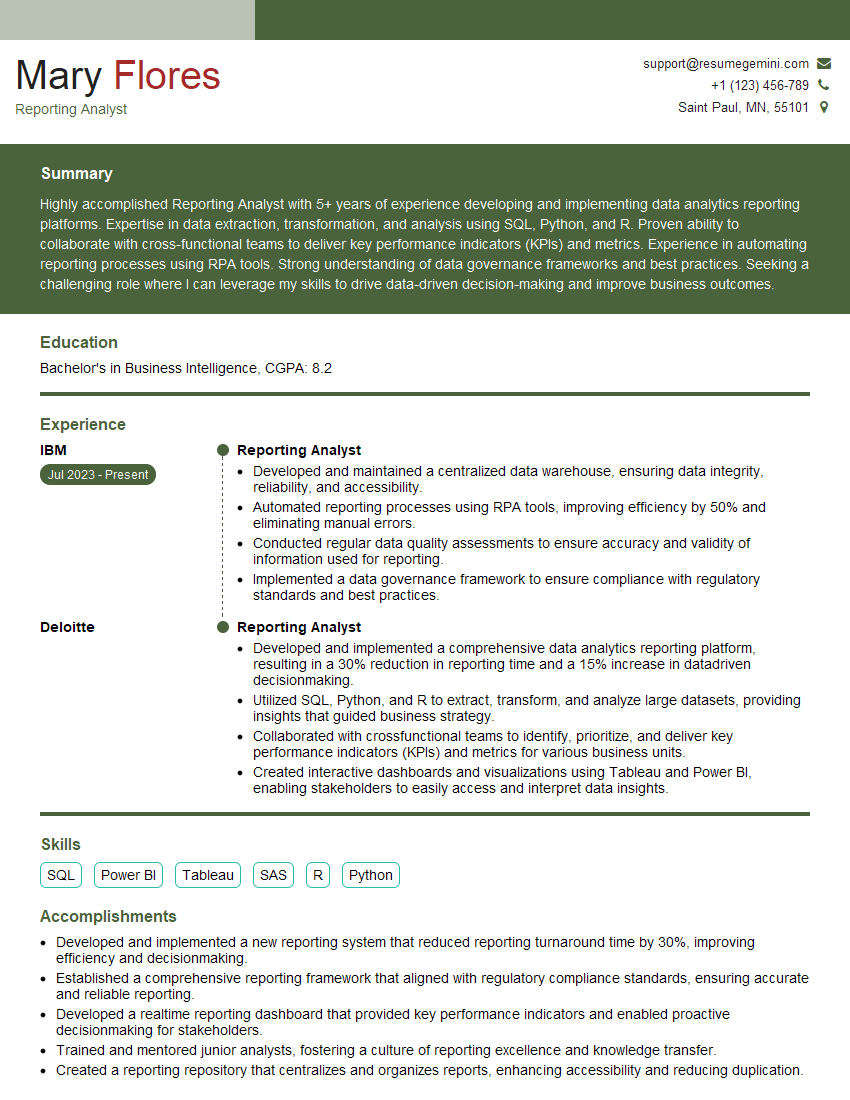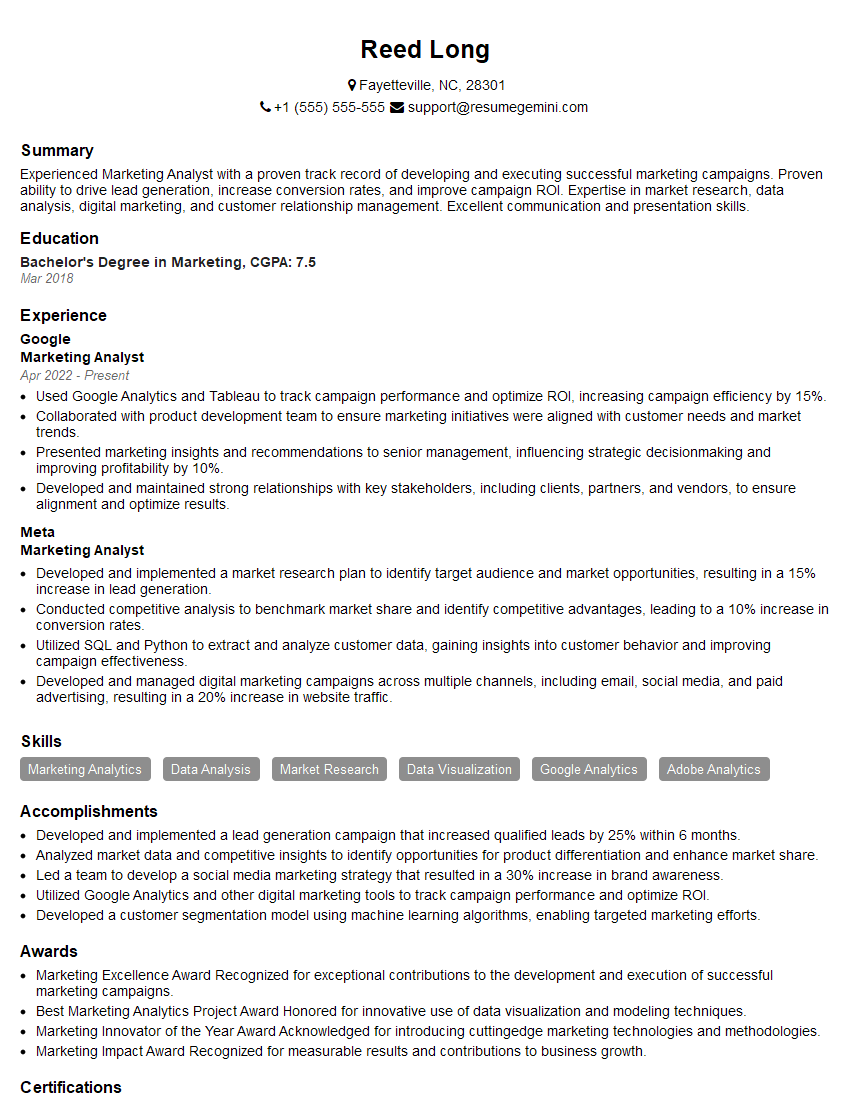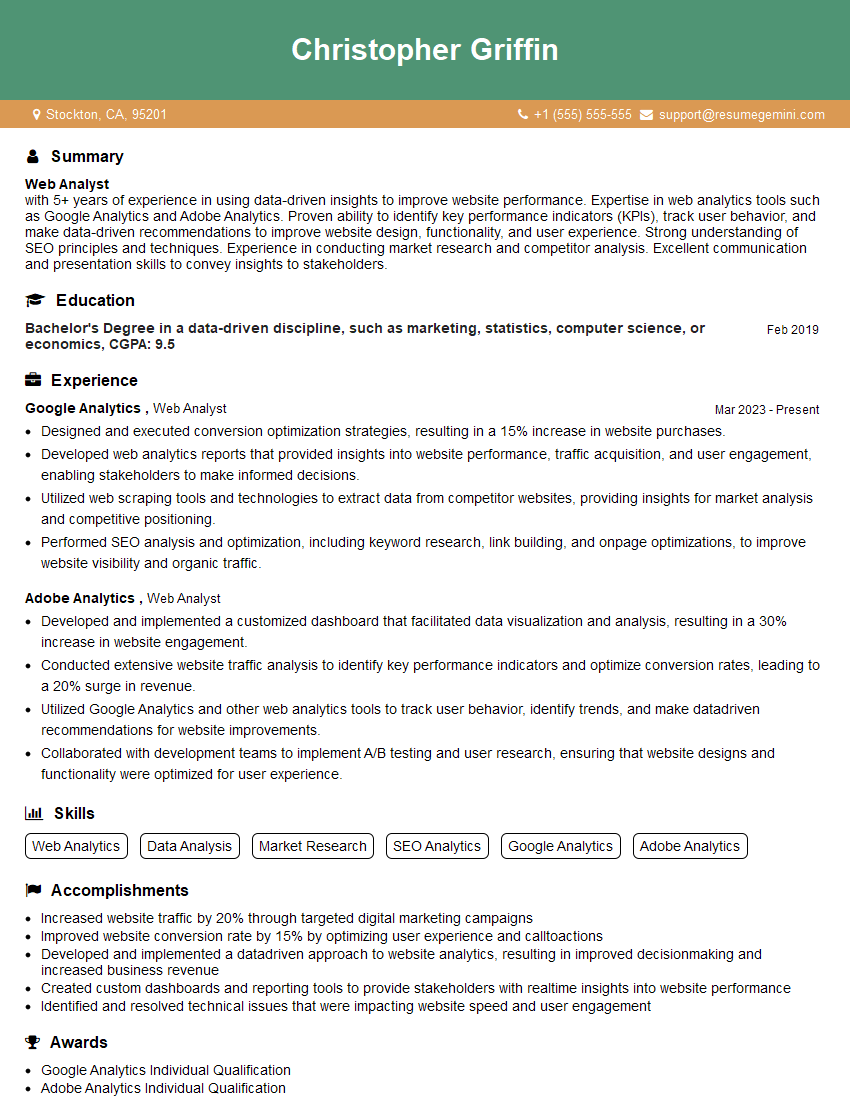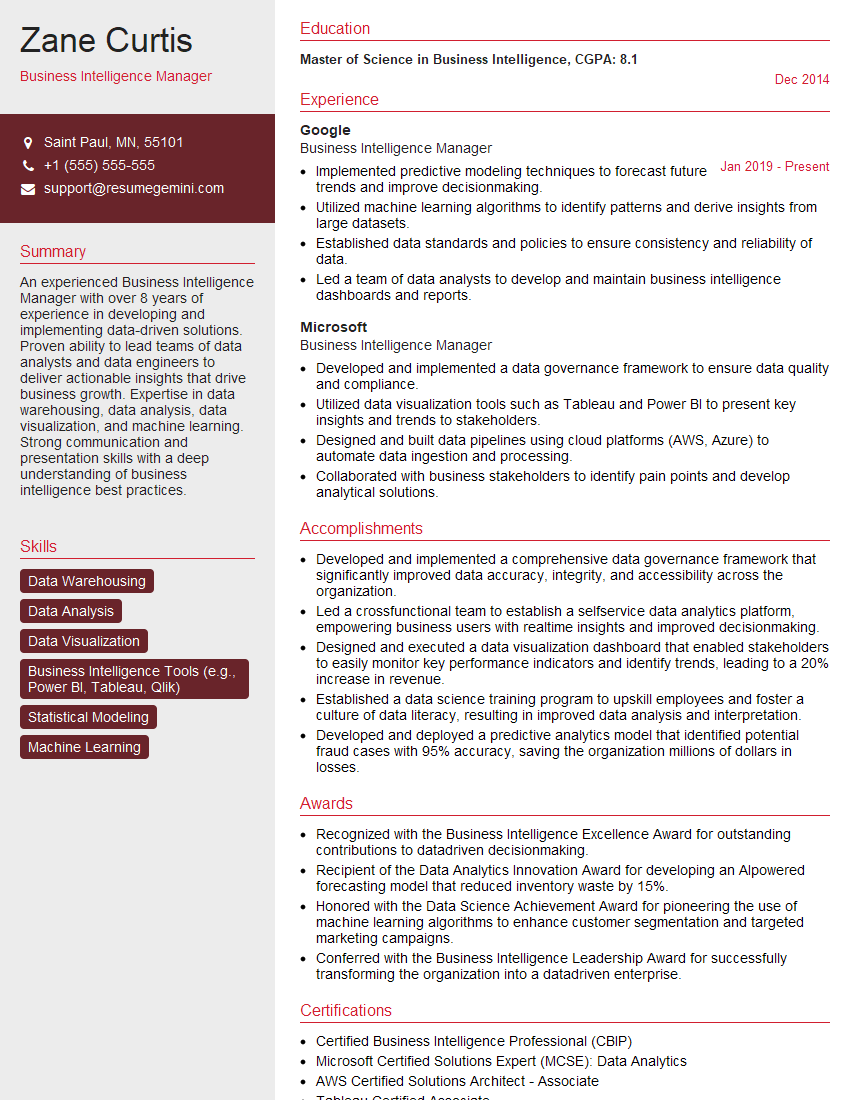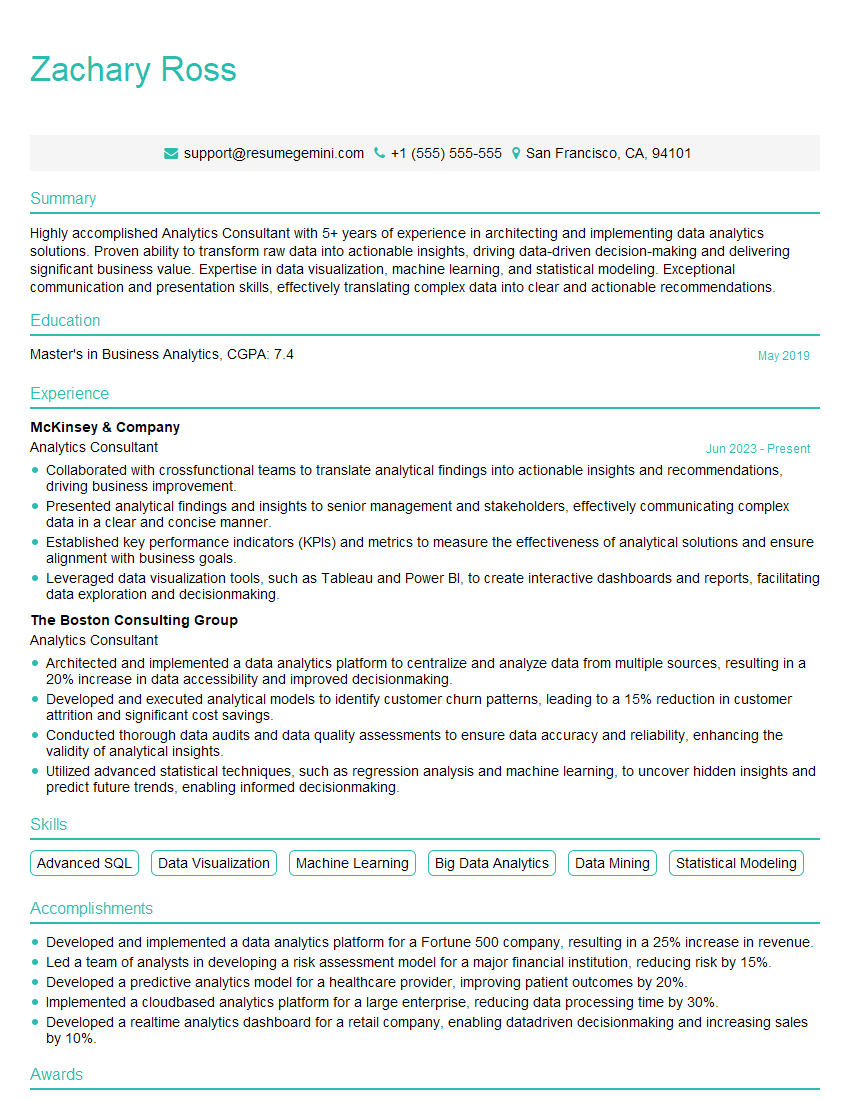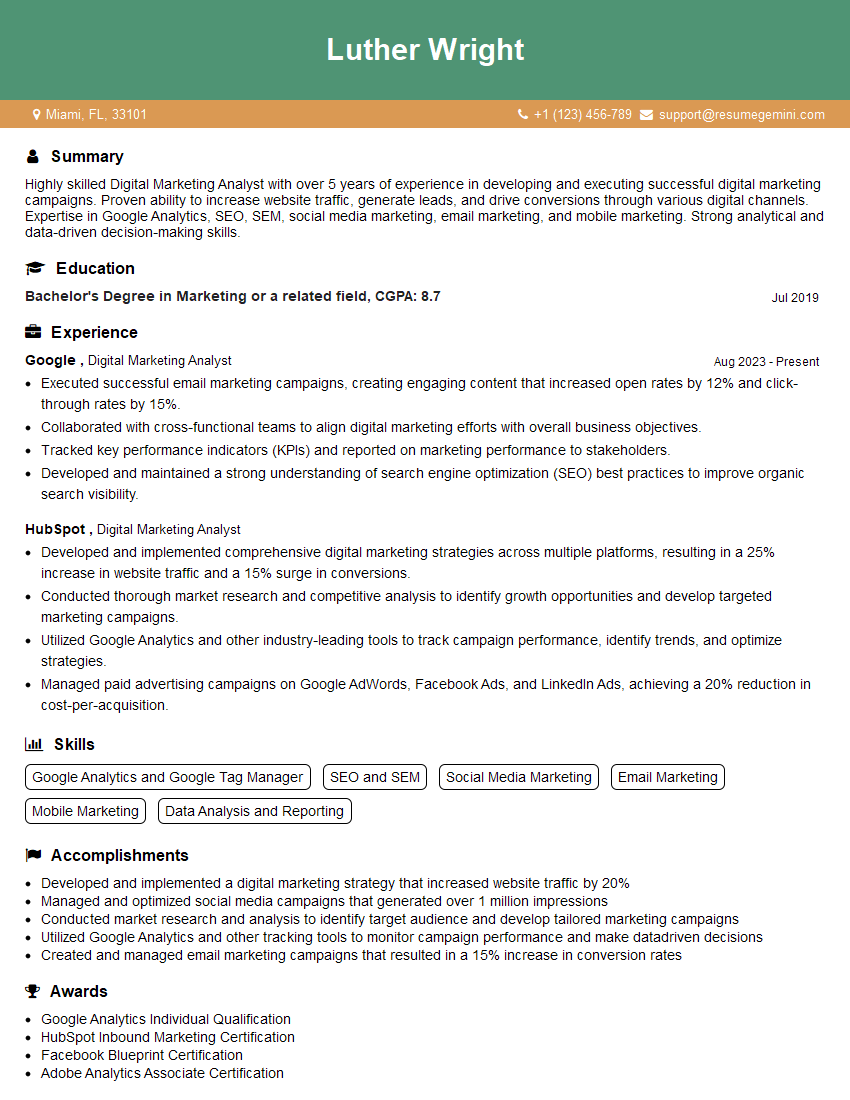Unlock your full potential by mastering the most common Key Performance Indicators (KPIs) Tracking and Analysis interview questions. This blog offers a deep dive into the critical topics, ensuring you’re not only prepared to answer but to excel. With these insights, you’ll approach your interview with clarity and confidence.
Questions Asked in Key Performance Indicators (KPIs) Tracking and Analysis Interview
Q 1. Explain the difference between leading and lagging KPIs.
Leading and lagging KPIs are two types of metrics used to track progress towards a goal. The key difference lies in their relationship to the outcome. Leading KPIs are predictive indicators that point towards future performance. They measure activities and processes that *influence* the outcome. Lagging KPIs, on the other hand, are retrospective measures that reflect past performance. They show the *results* of actions already taken.
- Example (Leading KPI): Number of marketing qualified leads (MQLs). A high number of MQLs suggests a strong likelihood of future sales, even before the sales are actually closed.
- Example (Lagging KPI): Customer churn rate. This reflects past customer losses and indicates the overall success (or failure) of customer retention strategies.
Think of it like driving a car: your speed (leading KPI) indicates where you’ll be in the future, while your current location (lagging KPI) shows where you are *now*, based on past speeds and directions.
Q 2. What are some common KPIs used in marketing?
Marketing uses a vast array of KPIs, but some of the most common include:
- Website Traffic: Unique visitors, page views, bounce rate, time on site. These metrics reveal website engagement and effectiveness.
- Social Media Engagement: Likes, shares, comments, follower growth. They show how well marketing resonates with the target audience on social platforms.
- Conversion Rate: Percentage of website visitors who complete a desired action (e.g., making a purchase, filling out a form). This is a critical measure of campaign success.
- Customer Acquisition Cost (CAC): The cost of acquiring a new customer. This helps assess the efficiency of marketing spending.
- Return on Investment (ROI): Measures the profitability of marketing campaigns. It’s calculated by dividing the net profit by the cost of the investment.
- Brand Awareness: Measured through surveys, social listening, or media mentions. It shows how well the brand is recognized and perceived.
The specific KPIs used will vary significantly depending on the marketing goals and the overall business strategy.
Q 3. How would you identify the most important KPIs for a specific business goal?
Identifying the most important KPIs starts with clearly defining the business goal. Let’s say the goal is to increase revenue by 15% in the next quarter. We then need to work backward to identify the key drivers of revenue. This often involves a combination of qualitative and quantitative analysis.
- Define the Business Goal: Be as specific and measurable as possible (e.g., increase revenue by 15% in Q4 2024).
- Identify Key Drivers: What factors directly influence revenue? This could include sales conversion rates, average order value, customer acquisition cost, and marketing campaign effectiveness.
- Select KPIs: Choose KPIs that directly measure these drivers. For our example, we might select conversion rates, average order value, customer acquisition cost, and marketing ROI.
- Set Targets: Assign specific, achievable targets for each KPI. For instance, increase conversion rates by 5%, average order value by 10%, and reduce customer acquisition cost by 7%.
- Monitor and Analyze: Regularly track the KPIs and analyze their performance. This allows for adjustments to strategies if the desired progress isn’t achieved.
Using a framework like this ensures the chosen KPIs are directly linked to the business objective, making them relevant and actionable.
Q 4. Describe your experience with KPI dashboards and reporting.
I have extensive experience in designing, developing, and implementing KPI dashboards and reporting systems. In previous roles, I’ve used tools like Tableau and Power BI to create interactive dashboards that visualize key performance data for various departments, including marketing, sales, and operations. My dashboards were designed to be user-friendly, providing clear, concise insights into performance trends, highlighting areas of strength and weakness. I’ve also developed automated reporting systems that deliver regular updates to stakeholders, ensuring they have the information they need to make data-driven decisions.
For example, I once created a dashboard for a marketing team that displayed key metrics like website traffic, lead generation, and conversion rates. This dashboard allowed the team to track the effectiveness of different marketing campaigns in real-time, enabling them to optimize their strategies for better results. The reporting aspect included automated weekly emails with key performance highlights and monthly deep-dive reports that analyzed campaign performance and provided recommendations for improvements.
Q 5. What tools and technologies are you proficient in for KPI tracking and analysis?
My proficiency spans several tools and technologies for KPI tracking and analysis. I’m highly skilled in using:
- Data Visualization Tools: Tableau, Power BI, Google Data Studio. These tools allow for the creation of interactive dashboards and reports that effectively communicate complex data.
- Data Analytics Platforms: Google Analytics, Adobe Analytics. These platforms provide valuable data on website traffic, user behavior, and marketing campaign performance.
- Programming Languages: Python (with libraries like Pandas and NumPy) and R. These are used for data cleaning, manipulation, and advanced statistical analysis.
- Database Management Systems: SQL (MySQL, PostgreSQL). Essential for accessing and querying data from various sources.
I also have experience with cloud-based data warehousing solutions like Snowflake and Google BigQuery for handling and processing large datasets.
Q 6. How do you handle incomplete or inaccurate KPI data?
Incomplete or inaccurate KPI data is a common challenge. My approach involves a multi-step process:
- Identify the Source of Inaccuracy: Investigate the root cause of the incomplete or inaccurate data. Is there a problem with data collection methods, data entry errors, or missing data points? Sometimes, this involves collaborating with other teams within the organization to identify the root cause.
- Data Cleaning and Imputation: If data is missing or contains errors, I use techniques like data imputation (filling in missing values using statistical methods) or data cleaning (removing outliers or correcting errors) to improve data quality. The specific method depends on the nature of the data and the extent of the missingness.
- Data Validation and Verification: After cleaning, I verify the accuracy of the cleaned data. This may involve cross-referencing data from different sources or performing consistency checks.
- Documenting Limitations: If significant data gaps remain, I transparently document these limitations in the analysis, explaining the potential impact on conclusions drawn from the incomplete data.
Transparency and careful consideration of the impact of incomplete data are crucial to maintaining the integrity of the analysis.
Q 7. Explain a situation where you had to justify a KPI’s relevance.
In a previous role, we were tracking customer satisfaction using a Net Promoter Score (NPS). Some stakeholders questioned its relevance, suggesting it didn’t accurately reflect the overall business health. To justify its relevance, I presented the following arguments:
- Correlation with Revenue: I showed a strong positive correlation between higher NPS scores and increased revenue. This demonstrated that satisfied customers are more likely to generate repeat business and positive word-of-mouth referrals.
- Early Warning System: I highlighted how changes in NPS could indicate emerging issues before they significantly impacted other lagging KPIs like customer churn. This showcased the predictive value of NPS.
- Actionable Insights: I demonstrated how the feedback gathered through NPS surveys could be used to identify areas for improvement and inform product development and customer service strategies. This showed its practical application.
By presenting this data-driven evidence, I effectively demonstrated the value and relevance of NPS as a key indicator of customer loyalty and future business growth, addressing the stakeholders’ concerns.
Q 8. How do you communicate KPI results to both technical and non-technical audiences?
Communicating KPI results effectively requires tailoring the message to the audience. For technical audiences, I use precise language, detailed data visualizations (like charts and graphs showing trends, outliers, and statistical significance), and even delve into the underlying methodologies. I might discuss confidence intervals, statistical tests, or the specifics of data collection. For non-technical audiences, I prioritize a clear, concise summary of key findings, using simple language and avoiding jargon. Visualizations are crucial here too, but I focus on high-level summaries – dashboards with key metrics presented visually. Instead of focusing on the how of the data, I emphasize the what – the key takeaways and their implications for business decisions. For example, instead of saying ‘Conversion rate decreased by 1.5% with a 95% confidence interval,’ I might say ‘Our website saw a slight dip in sales, suggesting we need to review our marketing strategies.’
For both groups, storytelling is key. I frame the data within the context of business objectives, explaining how the KPIs relate to overall goals and showing how performance is impacting the bottom line. This makes the data more relevant and engaging, regardless of the audience’s technical background.
Q 9. Describe your experience with A/B testing and its impact on KPIs.
A/B testing is a powerful tool for understanding which strategies are most effective. I have extensive experience designing and running A/B tests to optimize website conversion rates, email open rates, and user engagement. These tests typically involve creating two versions (A and B) of a webpage, email, or other element and randomly assigning users to each version. By tracking relevant KPIs – such as click-through rates, conversion rates, or time spent on page – we can determine which version performs better. For example, in one project, we A/B tested two different call-to-action buttons on a landing page. Version B, with a more compelling call to action, resulted in a 15% increase in conversion rates, a significant improvement directly measured by our KPI tracking system.
The impact of A/B testing on KPIs is directly measurable. It allows for data-driven decision-making, moving away from guesswork and intuition. We can confidently identify and implement changes that lead to tangible improvements in our key metrics. The results of these tests are then incorporated into our overall KPI reporting and analysis, providing valuable insights for future improvements.
Q 10. How do you ensure the accuracy and reliability of your KPI data?
Data accuracy and reliability are paramount. I ensure this through a multi-faceted approach. First, I meticulously review data sources, validating their accuracy and completeness. This involves checking for data integrity issues, such as missing values, inconsistencies, or outliers. Second, I implement robust data validation and cleaning processes. This may involve scripting in languages like Python or R to identify and handle missing data, correct errors, and eliminate duplicates. Third, I leverage data quality monitoring tools to continuously check for anomalies and potential errors in real-time. Finally, I rigorously document all data sources, processing steps, and methodology to ensure transparency and reproducibility.
Imagine a scenario where a critical KPI, like daily active users (DAU), is reported incorrectly due to a faulty tracking script. This would lead to incorrect business decisions. My approach ensures that we catch such errors early, using automated checks and manual validation to prevent inaccurate reporting.
Q 11. How do you identify and address biases in KPI data?
Identifying and addressing biases in KPI data is crucial for objective analysis. Biases can stem from various sources, including sampling bias (non-representative samples), measurement bias (flawed measurement tools), and reporting bias (selective reporting of results). I address these biases using several strategies. First, I carefully design data collection methods to minimize sampling bias, ensuring representative samples. Second, I critically evaluate measurement tools and processes to minimize measurement error. Third, I use statistical techniques like regression analysis to control for confounding variables and isolate the impact of specific factors on KPIs. Finally, I encourage transparency and scrutiny within the team to identify and discuss potential biases.
For example, if we’re evaluating the effectiveness of a new marketing campaign and only look at sales from one specific demographic, we might miss a broader positive impact on other demographics. Addressing this requires a broader analysis which accounts for all relevant user segments.
Q 12. What are some common challenges in KPI tracking and analysis?
Several challenges exist in KPI tracking and analysis. One is the sheer volume and complexity of data. We often need to integrate data from multiple sources, requiring significant data integration and cleaning efforts. Another challenge is choosing the right KPIs. Selecting relevant and meaningful KPIs that accurately reflect business goals is crucial, but can be challenging. Also, ensuring data accuracy and reliability, as mentioned earlier, is an ongoing process requiring continuous monitoring and validation. Finally, communicating findings effectively to both technical and non-technical audiences demands strong communication and visualization skills.
Consider the challenge of a rapidly growing e-commerce platform. It deals with massive datasets involving user behavior, product performance, marketing campaign effects, and more. Integrating this and understanding how these disparate pieces relate is a major undertaking.
Q 13. How do you prioritize KPIs when multiple exist?
Prioritizing KPIs is essential when dealing with multiple metrics. My approach involves a multi-step process. First, I align all KPIs with overall business objectives. This helps to eliminate irrelevant metrics. Then, I categorize KPIs based on their level of importance (e.g., high, medium, low). High-priority KPIs directly contribute to strategic business goals and should receive the most attention. Medium-priority KPIs support high-priority ones, while low-priority KPIs provide supplementary information. I may also employ a weighted scoring system, assigning weights to different KPIs based on their importance. Finally, I regularly review and adjust KPI priorities based on changing business needs and performance trends.
For example, if a company’s main objective is revenue growth, KPIs like revenue, conversion rate, and average order value would be high-priority, while customer satisfaction scores, although important, might be considered medium-priority.
Q 14. Explain the concept of ROI and its relationship to KPIs.
Return on Investment (ROI) measures the profitability of an investment. It’s calculated as (Gain from Investment – Cost of Investment) / Cost of Investment. KPIs are crucial for calculating and tracking ROI. Many KPIs directly contribute to the numerator (gain) or the denominator (cost) of the ROI calculation. For example, in a marketing campaign, KPIs like customer acquisition cost (CAC), conversion rate, and customer lifetime value (CLTV) are vital for determining ROI. A low CAC coupled with a high CLTV indicates a high ROI. Similarly, in a new product launch, KPIs such as sales revenue, production costs, and market share are crucial to evaluating ROI.
Monitoring relevant KPIs allows for continuous tracking and optimization of investment strategies. For instance, if a marketing campaign’s ROI is consistently low, we might adjust our spending, targeting, or messaging based on the specific KPIs that are underperforming. This demonstrates the interconnectedness between KPIs and the success, or lack thereof, of a business investment.
Q 15. How do you measure the effectiveness of a marketing campaign using KPIs?
Measuring the effectiveness of a marketing campaign relies on selecting and tracking the right Key Performance Indicators (KPIs). It’s not about just looking at numbers; it’s about understanding what those numbers mean in the context of your campaign goals. For example, a successful social media campaign might not just be about reaching a high number of impressions, but about driving meaningful engagement and conversions.
We start by defining clear objectives. What are we trying to achieve? Increased brand awareness? More leads? Higher sales? Once the objectives are set, we select KPIs that directly measure progress towards those goals. Here are some examples:
- Website Traffic: Measures visits to your website (e.g., using Google Analytics). We look at metrics like unique visitors, bounce rate, and average session duration.
- Conversion Rate: Tracks the percentage of website visitors who complete a desired action (e.g., making a purchase, signing up for a newsletter). This is crucial for understanding the effectiveness of your call to action.
- Cost Per Acquisition (CPA): Calculates the cost of acquiring a customer or lead. This is vital for budget management and ROI analysis. A lower CPA is generally better.
- Return on Investment (ROI): Measures the profitability of the campaign. It compares the net profit generated by the campaign to the total investment. This is the ultimate measure of success.
- Social Media Engagement: Includes metrics like likes, shares, comments, and mentions, indicating audience interest and reach. Understanding engagement rates is key to adjusting content strategy.
By analyzing these KPIs, we gain a comprehensive understanding of the campaign’s performance and identify areas that require adjustment. For example, if the conversion rate is low despite high website traffic, it suggests issues with the website design or call-to-action.
Career Expert Tips:
- Ace those interviews! Prepare effectively by reviewing the Top 50 Most Common Interview Questions on ResumeGemini.
- Navigate your job search with confidence! Explore a wide range of Career Tips on ResumeGemini. Learn about common challenges and recommendations to overcome them.
- Craft the perfect resume! Master the Art of Resume Writing with ResumeGemini’s guide. Showcase your unique qualifications and achievements effectively.
- Don’t miss out on holiday savings! Build your dream resume with ResumeGemini’s ATS optimized templates.
Q 16. How do you use KPIs to identify areas for improvement and optimization?
KPIs are instrumental in identifying areas for improvement and optimization. They provide a data-driven approach to refine strategies and maximize results. The process typically involves these steps:
- Data Collection and Analysis: Gather data from various sources, including website analytics, CRM systems, marketing automation platforms, and social media insights. Analyze trends and patterns in the KPI data.
- Benchmarking: Compare your KPIs to industry benchmarks or past performance. This helps identify areas where you are underperforming and where opportunities for improvement exist.
- Identifying Bottlenecks: Pinpoint the specific stages of the marketing funnel or customer journey where performance lags. For example, low conversion rates might indicate a problem with the landing page, while low click-through rates suggest problems with the ad copy or targeting.
- A/B Testing: Conduct A/B tests to compare different versions of marketing materials (e.g., website headlines, ad creatives, email subject lines) to see which performs better. This allows data-driven decision-making to optimize campaign performance.
- Iterative Improvement: Based on the analysis, implement changes and track the impact on your KPIs. This is an iterative process; continuously monitoring and adjusting based on real-time data.
Example: If we find that our email marketing campaign has a low open rate, we might test different subject lines or send times to see which improves engagement. This continuous optimization cycle is critical for maximizing the effectiveness of any marketing campaign.
Q 17. Describe your experience with different KPI visualization techniques.
Effective visualization is crucial for understanding and communicating KPI data. Different visualization techniques are better suited for different types of data and audiences. My experience spans various techniques:
- Dashboards: I’ve extensively used dashboards (e.g., using tools like Google Data Studio or Tableau) to present a comprehensive overview of key metrics. These provide a single view of multiple KPIs, allowing for quick identification of trends and anomalies.
- Charts and Graphs: Line charts are excellent for showcasing trends over time; bar charts for comparing different categories; pie charts for showing proportions; and scatter plots for identifying correlations between variables. I select the chart type based on the data and the message I want to convey.
- Maps: For geographically dispersed data, maps are invaluable for visualizing regional performance or identifying market opportunities. This is especially useful for businesses with a physical presence or targeting specific geographic areas.
- Infographics: When communicating KPI data to non-technical audiences, infographics are a powerful tool. They present complex information in a visually appealing and easily digestible format.
- Data Tables: While not always the most visually appealing, data tables are crucial for providing detailed information, particularly when needing to delve into granular data.
The key is to choose the right visualization technique to tell the story effectively. Overly complex visualizations can obscure the message, while simplistic ones might lack sufficient detail.
Q 18. What is your approach to setting realistic and achievable KPI targets?
Setting realistic and achievable KPI targets is critical for successful campaign management. Unrealistic goals can lead to demotivation, while overly ambitious targets might be unattainable. My approach involves:
- Data-Driven Targets: Start by analyzing historical data and industry benchmarks. This gives a baseline understanding of what’s achievable. It’s also important to consider external factors like seasonality or market trends.
- SMART Goals: Frame KPI targets using the SMART framework: Specific, Measurable, Achievable, Relevant, and Time-bound. For example, instead of ‘increase website traffic,’ aim for ‘increase website traffic by 20% in the next quarter’.
- Stakeholder Alignment: Collaborate with stakeholders (marketing, sales, executives) to ensure everyone understands and agrees on the targets. This alignment avoids discrepancies and confusion.
- Incremental Targets: Instead of aiming for drastic changes immediately, set incremental targets. This allows for a more sustainable approach and provides opportunities to learn and adjust along the way.
- Regular Review and Adjustment: Continuously monitor progress against targets and adjust as necessary. External factors might require adjustments, and learning from data allows for optimization along the way.
By employing this method, we ensure that our targets are not only attainable but also contribute to the overall business objectives, maintaining team motivation and maximizing campaign success.
Q 19. How do you track and analyze KPIs across multiple channels or platforms?
Tracking and analyzing KPIs across multiple channels requires a robust data integration strategy. Different platforms offer different data points, so using a single source of truth is key. I typically use a combination of techniques:
- Data Integration Platforms: Utilize tools like Google Marketing Platform or similar platforms that aggregate data from multiple channels (e.g., Google Ads, social media, email marketing) into a unified dashboard. This provides a holistic view of campaign performance.
- API Integrations: Where direct integrations aren’t available, I leverage APIs to extract data from various platforms and load it into a central data warehouse or database. This allows for more complex analysis and reporting.
- Custom Dashboards: Building custom dashboards using tools like Tableau or Power BI allows for flexible visualization and reporting, tailoring the data presentation to specific needs.
- Data Cleaning and Transformation: Data from different sources often needs cleaning and transformation to ensure consistency and accuracy. This includes handling missing values, standardizing data formats, and ensuring data integrity.
- Attribution Modeling: Assigning credit for conversions across different channels can be complex. I use appropriate attribution models (e.g., last-click, multi-touch) to understand the contribution of each channel to the overall outcome. This is particularly important for multi-channel marketing campaigns.
By carefully integrating and analyzing data from multiple channels, we gain a comprehensive understanding of customer journeys and identify opportunities for cross-channel optimization.
Q 20. How do you adapt your KPI tracking approach based on changes in business priorities?
Adapting KPI tracking to changes in business priorities is crucial for staying relevant and effective. It requires flexibility and a willingness to evolve the measurement framework.
My approach involves:
- Regularly Review Objectives: Periodically review business goals and objectives. Changes in market conditions, competition, or internal strategies often necessitate adjustments to KPIs.
- Identify Relevant KPIs: Based on the updated objectives, identify the KPIs that best reflect progress toward those goals. Some KPIs might become less relevant, while new ones might need to be added.
- Modify Data Collection: Adjust data collection methods to capture the new KPIs. This might involve integrating new data sources or modifying existing data collection processes.
- Communicate Changes: Clearly communicate any changes to the KPI tracking approach to all stakeholders. This ensures everyone is aligned and understands the updated metrics.
- Monitor and Iterate: Continuously monitor the effectiveness of the updated KPI framework and iterate based on performance and insights. Flexibility is key to adapting to changing circumstances.
For example, if a company shifts its focus from brand awareness to lead generation, the KPIs will change accordingly. The emphasis will shift from metrics like social media impressions to metrics like conversion rates and lead generation costs.
Q 21. Explain your process for identifying and defining relevant KPIs for a new project.
Identifying and defining relevant KPIs for a new project starts with a clear understanding of the project’s goals and objectives. This isn’t a one-size-fits-all process; each project requires a tailored approach. My process involves:
- Define Project Goals: Clearly articulate the project’s objectives. What are we trying to achieve? What are the key success factors?
- Identify Key Stages: Break down the project into its key stages or phases. This helps to identify specific milestones and areas where performance needs to be measured.
- Brainstorm Potential KPIs: Generate a list of potential KPIs that could measure progress at each stage. Involve stakeholders from different teams to ensure a comprehensive list.
- Prioritize KPIs: Select the most crucial KPIs based on their relevance to the project goals and their feasibility of measurement. It’s important to avoid KPI overload; focus on a few key metrics.
- Define Measurement Methods: Determine how each KPI will be measured. Specify the data sources, calculation methods, and reporting frequency.
- Establish Baselines: If possible, establish baseline values for each KPI. This provides a benchmark for measuring progress and identifying areas for improvement.
- Set Targets: Set realistic and achievable targets for each KPI. Use the SMART framework to ensure clarity and measurability.
By following these steps, we create a focused KPI framework that provides clear insights into the project’s performance and guides decision-making throughout the project lifecycle.
Q 22. How familiar are you with different statistical methods used in KPI analysis?
My familiarity with statistical methods used in KPI analysis is extensive. I regularly employ a range of techniques, tailored to the specific KPI and business context. These include descriptive statistics (mean, median, mode, standard deviation) to understand central tendency and data dispersion. Inferential statistics, such as hypothesis testing (t-tests, ANOVA) and regression analysis, are crucial for identifying significant trends and relationships between KPIs and other variables. For example, I might use regression analysis to determine the correlation between marketing spend (independent variable) and sales revenue (dependent variable). Time series analysis, including moving averages and exponential smoothing, is vital for forecasting future KPI performance and identifying seasonal patterns. Finally, I’m proficient in using techniques like control charts to monitor KPI performance over time and detect anomalies. The choice of method always depends on the data type, the research question, and the desired level of precision.
Q 23. What is your preferred method for presenting KPI data and insights?
My preferred method for presenting KPI data and insights prioritizes clarity, conciseness, and visual appeal. I strongly believe in using a combination of data visualization techniques tailored to the audience. For executive summaries, I favor concise dashboards showing key trends using charts like line graphs for time series data, bar charts for comparisons, and pie charts for proportions. For more detailed analyses, interactive dashboards allow stakeholders to drill down into the data and explore different perspectives. I also utilize clear, concise written reports that explain the findings in a non-technical manner, highlighting key insights and recommendations. Supporting these reports with tables for detailed data and appendices with technical details ensures transparency and completeness. The key is to select the visualization and communication style most effective for conveying the information to the intended audience.
Q 24. How do you utilize KPIs to make data-driven decisions?
I utilize KPIs to make data-driven decisions by establishing a clear link between KPI performance and strategic objectives. First, I identify the key business objectives and translate them into measurable KPIs. Then, I continuously monitor these KPIs, analyzing trends and deviations from targets. This allows me to identify areas performing well and those needing improvement. For example, a decline in customer satisfaction scores might prompt an investigation into customer service processes. I then use statistical methods to analyze the root causes of performance discrepancies. Finally, I translate these insights into actionable recommendations, using data to support decisions and measure the effectiveness of implemented changes. This iterative process, involving monitoring, analysis, and action, ensures that decisions are grounded in objective data and aligned with organizational goals. This data-driven approach minimizes guesswork and maximizes the likelihood of successful outcomes.
Q 25. Describe a time you identified an unexpected trend or anomaly in KPI data.
In a previous role, we were tracking website traffic and conversion rates. We noticed a sudden and significant spike in traffic from a specific geographic location, but the conversion rate remained unusually low. This was unexpected because we hadn’t launched any targeted campaigns in that region. Upon investigation, we discovered a significant number of bot-generated visits from that area, artificially inflating our traffic numbers. This anomaly, initially masked by focusing solely on the traffic increase, highlighted the importance of carefully considering multiple KPIs simultaneously and thoroughly investigating unexpected trends. We addressed the issue by implementing stricter bot filtering mechanisms on our website, leading to a more accurate representation of our actual website performance and a better understanding of genuine user behavior.
Q 26. How do you handle conflicting KPI data from different sources?
Handling conflicting KPI data from different sources requires a systematic approach. I begin by investigating the data sources themselves, verifying their reliability and accuracy. This includes understanding the data collection methods, potential biases, and the definitions used for each KPI. I then compare the data sets, looking for discrepancies and identifying potential reasons for the conflict. Differences could stem from variations in data definitions, sampling methods, or errors in data entry. I might use techniques like data reconciliation to identify and correct errors or inconsistencies. If the discrepancies cannot be resolved, I present the conflicting data transparently, highlighting the limitations of each source and explaining the potential reasons for the differences. This allows stakeholders to make informed decisions despite the uncertainty, recognizing the limitations of the available data. Transparency and a thorough understanding of the data limitations are key to navigating these situations effectively.
Q 27. How do you ensure data security and privacy when dealing with sensitive KPIs?
Data security and privacy are paramount when dealing with sensitive KPIs. I adhere to strict protocols to ensure compliance with relevant regulations (e.g., GDPR, CCPA). This involves secure data storage using encrypted databases and access control mechanisms. Only authorized personnel with a legitimate need to access the data are granted permission, and access is carefully monitored and logged. Data anonymization techniques are employed where possible to protect individual identities. Regular security audits and penetration testing are crucial for identifying vulnerabilities and proactively mitigating risks. Furthermore, data encryption during transmission and storage is essential, coupled with robust authentication procedures to prevent unauthorized access. A clear data governance policy that addresses data security, privacy, and ethical considerations is paramount for building a trustworthy and secure KPI tracking system.
Q 28. How would you explain the importance of KPI tracking to a non-technical stakeholder?
Imagine you’re running a marathon. You wouldn’t just run without checking your pace or how far you’ve gone, right? KPI tracking is like having those mile markers during your marathon. It provides critical insights into your progress towards your goals. Instead of blindly running, KPIs give you a clear picture of what’s working, what’s not, and where adjustments are needed. By tracking key metrics, we can identify areas of strength and weakness, allowing for proactive interventions and strategic adjustments. Ultimately, KPI tracking helps ensure that you reach your destination (business goals) effectively and efficiently. It helps to avoid costly mistakes, improve operational efficiency, and ultimately drive better business outcomes – essentially, winning the race.
Key Topics to Learn for Key Performance Indicators (KPIs) Tracking and Analysis Interview
- Defining and Selecting KPIs: Understanding the business goals and translating them into measurable KPIs. This includes choosing the right metrics for different departments and levels of the organization.
- Data Collection and Integration: Exploring various data sources (databases, spreadsheets, CRM systems) and techniques for accurate and efficient data collection. Understanding data cleaning and transformation processes is crucial.
- KPI Tracking and Monitoring: Mastering the use of dashboards and reporting tools to visualize KPI performance. This includes understanding different chart types and their appropriate uses.
- Data Analysis and Interpretation: Moving beyond simply tracking data to understanding trends, identifying outliers, and drawing meaningful conclusions. This includes utilizing statistical analysis techniques where applicable.
- Reporting and Communication: Effectively communicating KPI performance to stakeholders through clear, concise reports and presentations. This involves tailoring your communication to the audience’s level of understanding.
- Actionable Insights and Recommendations: Transforming data insights into concrete recommendations for improvement. This involves identifying areas for optimization and suggesting strategies to achieve better results.
- Technology and Tools: Familiarity with relevant software and tools used for KPI tracking and analysis (e.g., data visualization platforms, business intelligence software). Be prepared to discuss your experience with specific tools.
- Forecasting and Predictive Modeling: Understanding how to use historical data to forecast future KPI performance. This may involve basic forecasting techniques or more advanced statistical modeling.
Next Steps
Mastering KPI Tracking and Analysis significantly enhances your value to any organization. It demonstrates your analytical skills, your ability to contribute directly to business success, and your capacity to drive data-informed decision-making. To showcase these skills effectively, crafting a strong, ATS-friendly resume is paramount. ResumeGemini is a trusted resource to help you build a professional and impactful resume that highlights your expertise. Examples of resumes tailored to Key Performance Indicators (KPIs) Tracking and Analysis are available to help guide your creation process.
Explore more articles
Users Rating of Our Blogs
Share Your Experience
We value your feedback! Please rate our content and share your thoughts (optional).
What Readers Say About Our Blog
Interesting Article, I liked the depth of knowledge you’ve shared.
Helpful, thanks for sharing.
Hi, I represent a social media marketing agency and liked your blog
Hi, I represent an SEO company that specialises in getting you AI citations and higher rankings on Google. I’d like to offer you a 100% free SEO audit for your website. Would you be interested?
